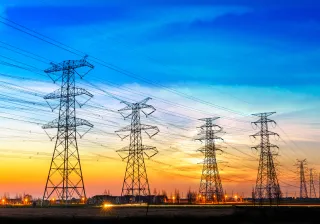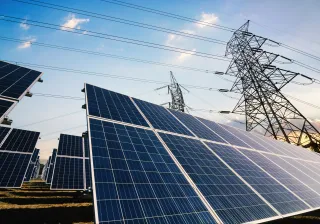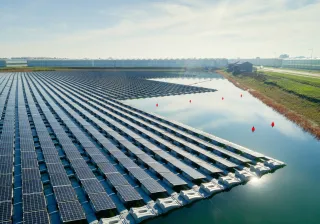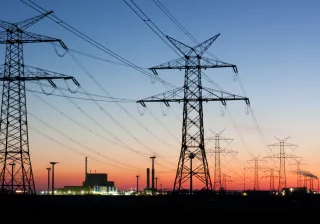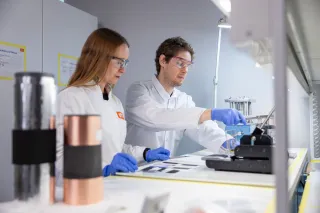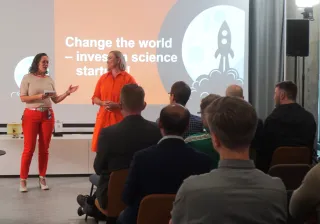The supermarket S-Market Ritaharju in Oulu, operated by the Arina Cooperative Association (part of the S-Group), uses the waste heat from its refrigeration equipment for its own heating needs while also contributing excess low-emission energy into the district heating network. This solution is a result of well-established cooperation with VTT and the related partners. The concept of waste heat utilization as district heat is now expanding, and the development continues. In the future, this will lead to the dual-use of district heating networks as energy storage.
The development of new energy solutions between VTT and Arina began years ago with improvements to the energy efficiency of Arina's retail outlets. Since then, the focus has shifted to emission-free energy.
The long project continuum has produced good and even surprising results as the new energy production solution for the Ritaharju S-Market shows. The solution is based on the utilisation of waste heat from the CO2 cooling facility either for the building itself or by delivering it to the district heating network.
The concept turns the market into an efficient heat production facility. The produced energy can heat 150 detached houses with a minimal carbon footprint. Previously excess heat from the store was evaporated into outside air. Now it’s recovered for the benefit of customers and the operator of the district heating network. VTT developed the basic idea for the solution and procured funding for European-wide research and development effort in the Making-City project. The total EU funding was in the millions of euros.
“The concept alters the entire business model. The supermarket does not buy heating energy. Instead, the district heating company invests in the equipment inside the market and agrees to buy the resulting energy, while guaranteeing the supermarket the service that it needs. “The model produces great overall benefits and enables faster investments in low-emission energy”, explains Tuomas Paaso, owner of the Making-City Project at VTT.
Concept to be extended to other retail outlets of the S-Group cooperative
Arina has implemented the concept at the Ritaharju S-Market together with Oulun Energia and Caverion. VTT is responsible for the metering technology at the location, collecting measurement data, and issuing reports on the performance of the solution.
The concept is now being extended to other outlets of the S-Group, starting in the north of Finland. The vision of the S-Group is to reduce all carbon emissions from the markets’ district heating to zero. Doing this would require 110 markets to follow the same concept. Eleven retail outlets are enough to bring the emissions of all the markets in the north of Finland to zero, and this is to be implemented by 2025. The work is easier in Northern Finland because many low-energy markets have already been established with energy consumption which is just 50% of the normal level.
The companies are also holding discussions with other possible partners on expanding the concept. “The benefits are considerable, and I hope that the solution becomes widespread. If the best technology is used by only some of the companies, this would be a loss to the entire energy sector”, says the father of the idea, Principal Scientist Klaus Känsälä at VTT.
Return heat to be utilised next
Although the concept itself is expandable, its development continues, and next step is to feed heat into the return pipes of the district heating network.
The temperature of the waste heat in the pipeline going into the district heating network would first need to be raised to 90–95 degrees centigrade using a heat pump. The temperature in the return pipes does not need to be that high. In practice, 40–45 degrees is enough. This is a considerable improvement to overall efficiency.
The return heat solution is interesting from the point of view of regional heating companies.
“The companies are wondering where to get heat in the future. Possible solutions have included extracting heat from the sea, but using cold sea water with heat pumps consumes large amounts of energy. Taking part of the heat from the return pipes would lead to lower energy consumption”, Känsälä ponders.
The return heat solution has already been piloted, but VTT wants to test it in a more extensive project. One possible target could be, for example, a housing fair area or a residential district where the return pipes would be used for heat transfer in a way that is similar to the one used in low temperature networks. This would make it possible to build up to 30% more floor space with the same amount of piping, while improving the features of the network itself.
Potential in flexibility trading for energy
The solution also has interesting potential for the control of energy regulating power and the energy flexibility market.
“A smart energy management solution can enable, for example, the use of a district heating network for energy storage and as a source of regulating power. This would enable more efficient utilisation of renewable energy sources, reduce emissions, ease the management of regulating power, while adding a time buffer to the network”, Paaso says.
“This would make it possible to build a completely new energy community model that would benefit both end-users and producers of electrical energy”, Känsälä says.



